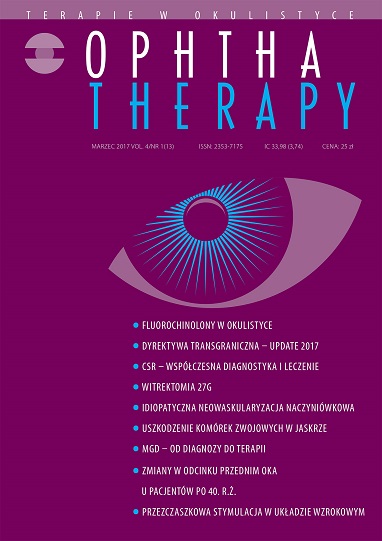Physiological changes within the ocular surface in the 40+ patients
Main Article Content
Abstract
Age-related changes of the ocular surface and corneal tissue lead to alterations of the tear fi lm, decreased vision and greater discomfort. Th e age-related changes aff ect most of the elements of the ocular surface system. Tear production decreases, infl ammation and fi brosis of the lacrimal ducts are more frequently observed. Keratinisation of meibomian glands occurs, as the composition of meibum is altered. Th e number of corneal nerves decreases, the level of sex hormones diminishes, and the immune system ages. Th e major age-related changes are summarized in the article.
Downloads
Article Details

This work is licensed under a Creative Commons Attribution-NonCommercial-NoDerivatives 4.0 International License.
Copyright: © Medical Education sp. z o.o. License allowing third parties to copy and redistribute the material in any medium or format and to remix, transform, and build upon the material, provided the original work is properly cited and states its license.
Address reprint requests to: Medical Education, Marcin Kuźma (marcin.kuzma@mededu.pl)
References
2. Research in dry eye: report of the Research Subcommittee of the International Dry Eye WorkShop (2007). Ocul Surf. 2007; 5(2): 179-93.
3. Knop E, Knop N, Millar T et al. The international workshop on meibomian gland dysfunction: report of the subcommittee on anatomy, physiology, and pathophysiology of the meibomian gland. Invest Ophthalmol Vis Sci. 2011; 52(4): 1938-78.
4. McGill JI, Liakos GM, Goulding N et al. Normal tear protein profiles and age-related changes. Br J Ophthalmol. 1984; 68(5): 316-20.
5. Roszkowska AM, Colosi P, Ferreri FMB et al. Age-related modifications of corneal sensitivity. Ophthalmologica. 2004; 218(5): 350-5.
6. Niederer RL, Perumal D, Sherwin T, McGhee CNJ. Age-related differences in the normal human cornea: a laser scanning in vivo confocal microscopy study. Br J Ophthalmol. 2007; 91(9): 1165-9. https://doi.org/10.1136/bjo.2006.112656.
7. Sullivan DA. Tearful relationships? Sex, hormones, the lacrimal gland, and aqueous-deficient dry eye. Ocul Surf. 2004; 2(2): 92-123.
8. The epidemiology of dry eye disease: report of the Epidemiology Subcommittee of the International Dry Eye WorkShop (2007). Ocul Surf. 2007; 5(2): 93-107.
9. Yu J, Asche CV, Fairchild CJ. The economic burden of dry eye disease in the United States: a decision tree analysis. Cornea. 2011; 30(4): 379-87.
10. Berlau J, Becker HH, Stave J et al. Depth and age-dependent distribution of keratocytes in healthy human corneas: a study using scanning-slit confocal microscopy in vivo. J Cataract Refract Surg. 2002; 28(4): 611-6.
11. Schimmelpfennig BH. Direct and indirect determination of nonuniform cell density distribution in human corneal endothelium. Invest Ophthalmol Vis Sci. 1984; 25(2): 223-9.
12. Sperling S, Gundersen HJ. The precision of unbiased estimates of numerical density of endothelial cells in donor cornea. Acta Ophthalmol (Copenh). 1978; 56(5): 793-802.
13. Azen SP, Smith RE, Burg KA et al. Variation in central and vertical corneal endothelial cell density in normal subjects. Acta Ophthalmol (Copenh). 1981; 59(1): 94-9.

